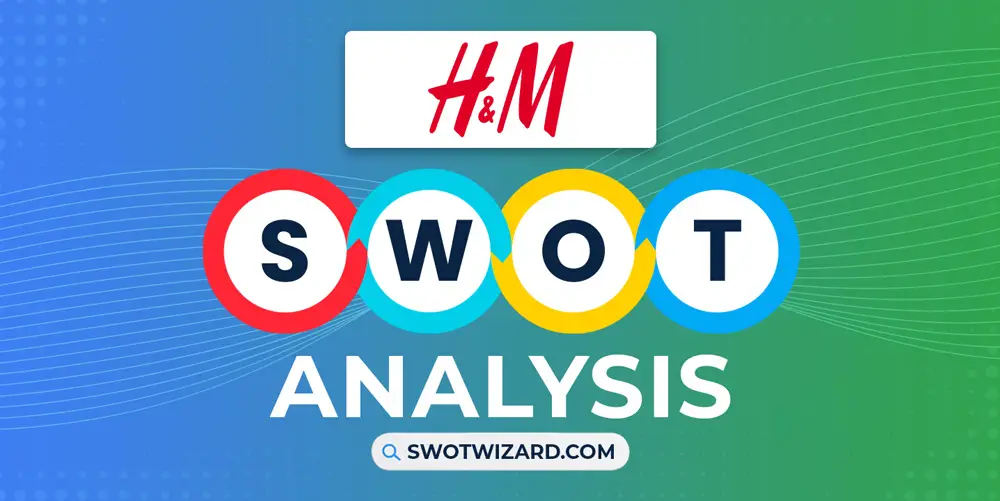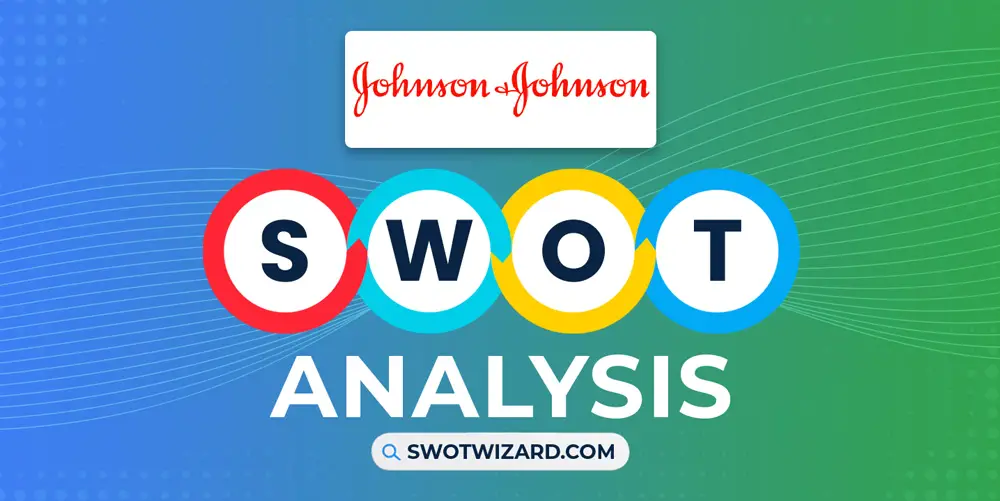Whether you can afford a luxury product or not, you have heard the brands like Zara and H&M., and if you’re from a first-world country, you already have seen an H&M store, and even If you’re not and lives in a third-world country like me, you must have seen counterfeit H&M products in the street.
Behind this much popularity and exposure, H&M has various strengths, weaknesses, opportunities, and threats they regularly tackle, which we will get to know in this h&m swot analysis.
H&M: Company Overview
| Company | H&M |
| Industry | Retail |
| Founded | 1947 |
| Founder | Erling Persson |
| President & CEO | Helena Helmersson |
| Headquarter | Stockholm, Sweden |
| No. of Employees | 107,375+ |
| Annual Revenue | $24.8 billion (FY 2019) |
| Website | hm.com |
H&M is a Swedish multinational fashion retailer founded in 1947 by Erling Persson in Västerås, Sweden. Starting with a few stores, the company has grown into one of the world’s largest clothing retailers, with over 4,465 stores in more than 78 countries worldwide.
The company reported total revenue of £722.6 B and had around 106,522 employees. The company aims to offer fashion and quality at the best price sustainably. The company has also committed to sustainability and ethical practices, including using more sustainable materials and implementing a garment collection program.
Product & Services of H&M
Sportswear | Underwear | Shoes | Accessories | Cosmetics | Home Textiles | Decorations
H&M Competitors
Zara | Uniqlo | Gap | ASOS | Macy’s | American Eagle Outfitters | Forever 21 | Topshop | Louis Vuitton
Did You Know?
H&M was the first fashion company to launch a global campaign promoting sustainable fashion called “Close the Loop.” And after that, it became a trend in the industry.
Strengths – H&M SWOT Analysis
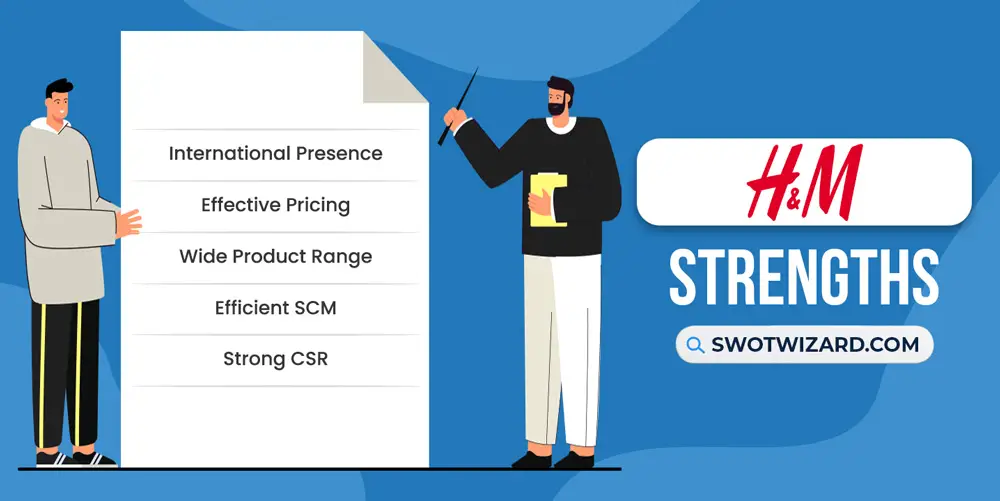
International Presence: With 4,465 stores in over 78 countries worldwide as of 2022, H&M has a solid global presence. Europe is the company’s largest market, with over 2,000 stores, followed by Asia, with over 1,200 stores. The company also has a significant presence in North America, South America, Africa, and the Middle East.
Effective Pricing: The company offers affordable and trendy clothing with prices typically lower than its competitors. According to the data, the average price of an H&M product was around $27, compared to $38 for Zara in 2022. H&M’s effective pricing strategy has helped the company remain a leading fast fashion retailer.
Wide Product Range: H&M offers a wide range of products for men, women, and children, including clothing, accessories, and home decor, and its product range includes over a hundred million individual items. With the product range this big, it allows H&M to appeal to a broad customer base.
Efficient SCM: The company’s SCM is designed to be flexible and adaptable, focusing on speed and cost-effectiveness. As a result, it can bring new products to market in as little as two weeks, and the company’s lead times for production are among the shortest in the industry.
Strong CSR: With a focus on sustainability, ethical practices, and community engagement, the company constantly works to build a solid commitment to corporate social responsibility. Recently, the company has sourced 57% of its materials sustainably and recycled over 60K tonnes of textiles and sets the goal to use 100% sustainably sourced materials by 2030.
Weaknesses – H&M SWOT Analysis
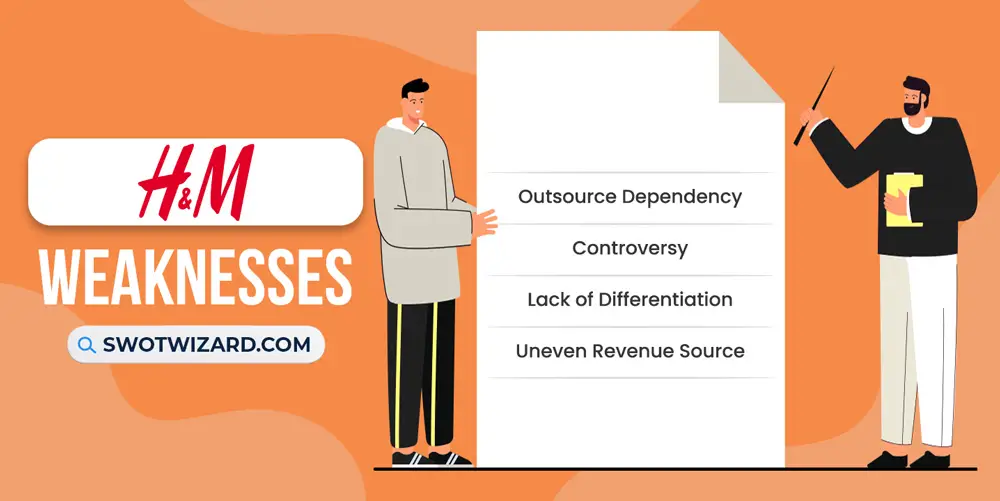
Outsource Dependency: As per the stats, 98% of H&M’s products is manufactured by external suppliers, with almost 2000 suppliers in over 40 countries worldwide. Besides, The company has faced criticism over labor abuses and poor working conditions in its supply chain, particularly in third-world countries such as Bangladesh and Cambodia.
Controversy: Several controversies in the last few years affected the company, such as being accused of burning unsold clothing, faced criticism over working conditions in its supply chain and the use of toxic chemicals in its manufacturing processes, a monkey ad that faced a massive backlash, and recently human right violation in China in 2022.
Lack of Differentiation: The lack of differentiation impacts H&M’s ability to stand out in a crowded market. As the company has been accused of using copies or similarly designed products, consumers are getting the same product, and from their perspective, it’s overpriced, thus resulting in decreasing foot traffic in the stores.
Uneven Revenue Source: The company’s revenue sources are unevenly distributed, making it vulnerable to economic downturns and other disruptions. As per the data, Europe accounted for over 70% of H&M’s sales, while the Americas accounted for 13% and Asia and Oceania accounted for 9%, and any disruption could impact the company’s overall revenue.
Opportunities – H&M SWOT Analysis

Product Diversification: The company has the opportunity to diversify its product offerings beyond clothing and accessories. As a part of the process, H&M announced plans to launch a home decor collection in select markets following the success of its H&M Beauty line.
Market Expansion: H&M has reached many countries with thousands of stores, but not all. As a result, the company can or has the opportunity to expand its market share by targeting emerging markets, particularly in Asia and Africa, focusing on increasing e-commerce sales and introducing more localized product offerings.
Strategic A&P: H&M has made several strategic acquisitions and partnerships in recent years, including the acquisition of fashion tech company Ivyrevel and a partnership with resale platform Sellpy. And the company is continuously collaborating and partnering with different brands, such as in collaboration with Shopee in the Thai e-commerce window.
Sustainability Campaigns: As consumers become more environmentally conscious, there is a growing demand for sustainable fashion. As the company already has positioned itself as a great sustainability admirer and working through that, it has an opportunity to capitalize on this trend by expanding its sustainable product offerings and promoting its environmental initiatives.
E-commerce Centralization: Online sales have increased up to eighty percent in some cases, and clothing was one of them. And H&M has significant opportunities for growth in e-commerce, centralizing, and other e-commerce capabilities, such as offering click-and-collect and same-day delivery options.
Threats – H&M SWOT Analysis
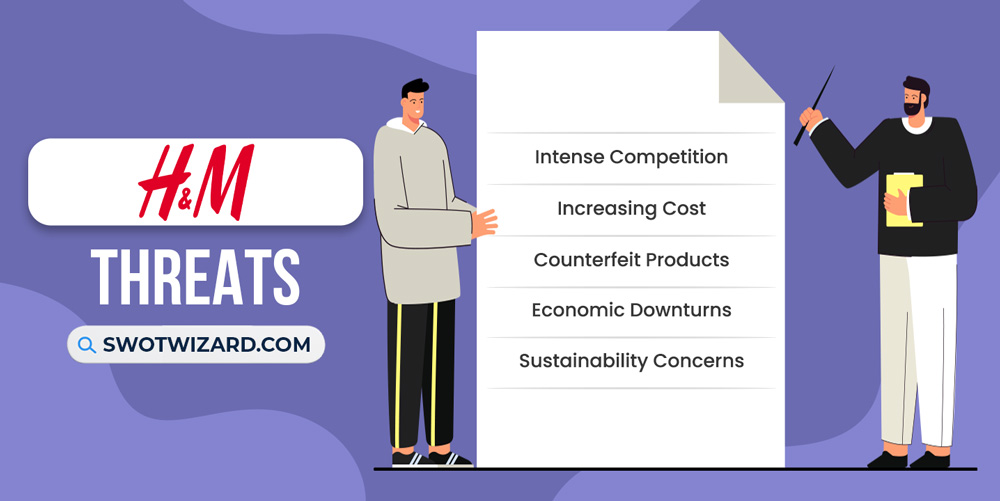
Intense Competition: The company competes with various major players in the clothing industry, including other fast fashion brands, luxury brands, and online retailers. In 2020, H&M’s main competitors included Zara, PVH, Gap, Fast Retailing, UNIQLO, Inditex, Primark, etc.
Increasing Cost: H&M faces rising cost pressures, particularly regarding raw materials and labor costs. In the last year, 2022, the company had to let go of more than 1500 people because of rising prices. Besides, this year, 2023, the overall profitability has decreased considerably.
Counterfeit Products: As a renowned brand, H&M has been facing a threat from counterfeit products, which can damage the company’s reputation and revenue. In the last few years, the market size of clothing and counterfeit products has risen immensely, a threat to H&M and other fashion brands.
Economic Downturns: The world is going through multiple economic rollercoasters, with inflation hitting the countries pretty hard. Besides, a recession is coming this year or the next, and because of the economic slowdown in Europe in recent years, we can already see the graph going down in the clothing industry.
Sustainability Concerns: H&M has faced criticism over its environmental impact and labor practices multiple times. In the last year, 2022, the company was found lying about its sustainability goals and sued for greenwashing claims. It indeed dampens the company’s reputation.
[Bonus Infographic] SWOT Analysis of H&M
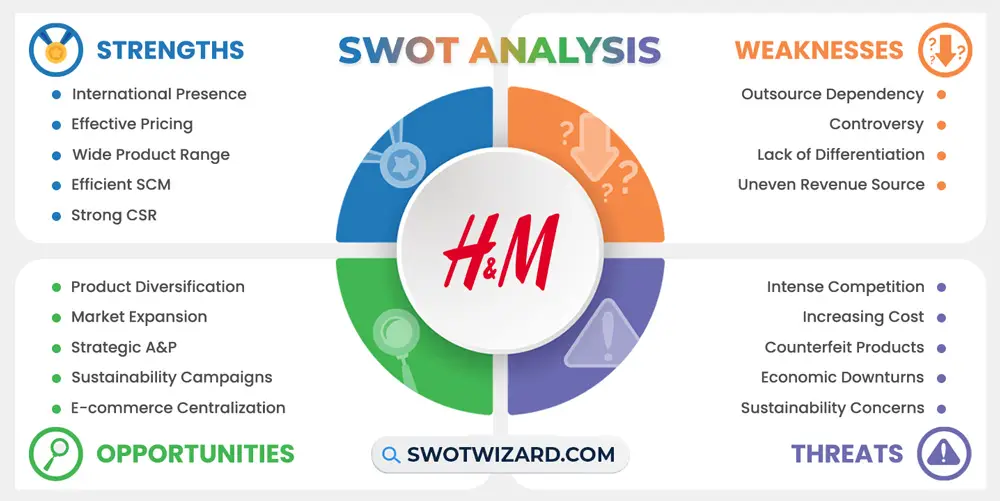
Recommendations for H&M
The fast fashion industry will undergo significant changes in the following years. The company needs to adjust and prioritize a few things to survive in the coming years.
- To diversify its revenue sources and attract new customers, the company should explore new product categories, such as beauty, home decor, or technology accessories.
- H&M should prioritize investing in its e-commerce capabilities, offering a more personalized experience, improving the online shopping experience, and expanding delivery options to reach new customers.
- The company has the opportunity to expand into new markets, particularly in Asia and Africa, to diversify its revenue sources and reduce its dependence on Europe.
- More strategic partnerships and acquiring innovative tech could help the company improve its overall operational excellence.
- Improving the company’s supply chain transparency and increasing oversight of its suppliers to ensure ethical and sustainable practices will reduce the risks regarding supply chain management.
Frequently Asked Questions (FAQs)
Where are H&M Clothes Made?
H&M clothes are made in China, Bangladesh, and Turkey.
Is H&M a high-end brand?
Yes, H&M is a high-end brand.
Final Words on H&M SWOT Analysis
H&M is a global fast fashion brand focusing on sustainability and corporate social responsibility. The company has a significant opportunity for growth in e-commerce and expansion into new markets and product categories. However, H&M faces challenges, including uneven revenue sources and ongoing concerns about its sustainability practices. But, it is well-positioned and continues its growth and innovation.
References
- Wikipedia contributors. (n.d.). FedEx. Wikipedia.
- Aaker, D. (2016, April 26). Six Reasons to Admire the Sephora Brand. LinkedIn.
- Carrara, A. (2023, January 27). LVMH’s record-breaking results driven by Sephora. Cosmetics Business.
- Hopp, D. (2022, August 29). 15 Weird (But True) Facts About Sephora. Byrdie.
- Dries, K. (2014, November 7). Big Sephora Sale Marred by Tech Issues, Accusations of Racism. Jezebel.
- T. (2018, November 15). 20 Reasons Why Sephora Lost Our Trust (Forever). TheTalko.
- Pomarico, N. (2016, July 15). Things About Sephora You Didn’t Know. The List.
- Stewart, K. (2018, July 23). 5 ways Sephora creates a seamless customer experience. NRF.
- Deslandes, M. (2022, February 10). Zara and H&M: How do these two retail giants differ? FashionNetwork.
- Peterson, H. (2014, September 13). How H&M Churns Out New Styles In Just 2 Weeks. Business Insider.
- Holbrook, E. (2019, April 2). H&M Reports 57% of All Materials Used in Production are Sustainable. Environment + Energy Leader.
- H&M responds to sacking of Bangladesh garment workers, says ‘deeply concerned.’ (2019, February 7). bdnews24.com.
- H&M returns to Alibaba’s Tmall, 16 months after Xinjiang controversy. (2022, August 16). CNBC.
- H&M India introduces home furnishing brand H&M Home in both online, offline formats. (2022, February 2). The Economic Times.
- Hanbury, M. (2018, May 9). H&M is making a drastic change to keep up with its rivals and get rid of its mountain of unsold clothes. Business Insider.
- Pengrattana, K. (2022, October 23). H&M collabs with Shopee to expand in Thai e-commerce. ScandAsia.
- DeAcetis, J. (2021, May 6). H&M Drives Innovation In Sustainability With 2021 Style. Forbes.
- Moss, T. (2023, January 27). H&M Profit Battered by Rising Costs, Russia Exit. The Wall Street Journal.

